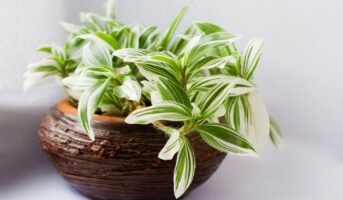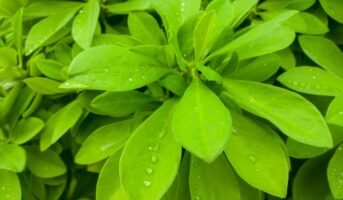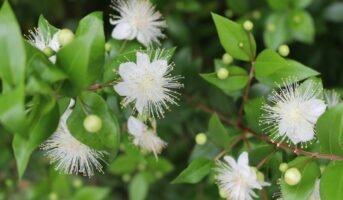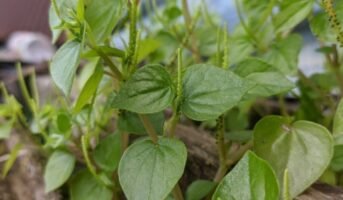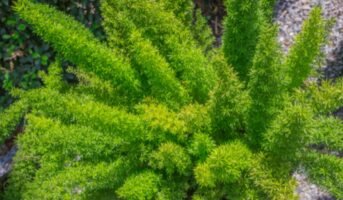An excellent approach to bringing colour indoors is by growing flame violets (Episcia cupreata). Houseplants with Episcia flame violets feature velvety leaves and blooms that resemble those of its African violet relative. When you know the fundamentals, caring for Episcia flame violets is simple, you will receive a beautiful indoor flowering specimen as payment.
The flame violet plant has a variety of varieties. Many dangle from hanging baskets’ sides. Native to North and South America, Episcia Cupreata flame violet houseplants have leaves that range in color from green to bronze, scarlet, or even chocolate. Leaves with an oval form can have silvery veins, margins, or edges. They have a modest growth habit and bloom all year long in red, pink, orange, yellow, lavender, or white.
Episcia Cupreata: Quick facts
| Genus | Episcia |
|---|---|
| Species | Cupreata |
| Family | Gesneriaceae |
| Dimensions | Height: between 0 and 1 foot, 6 inches.
Width: 1 to 2 feet, 0 inches |
| Available Space To Plant | 12 inches or less
also 12 inches to 3 feet |
| Life Cycle | Perennial |
| Leaf Color | Green, Orange, Purple/Lavender |
| Flower Color | Gold/Yellow, Orange |
| Stem Description | hirsute, 19.5″ long, and easily rooted stolons. |
| Landscape Place | Hanging containers with baskets |
Description of the plant
This Gesneriaceae family herbaceous perennial is frequently cultivated indoors. It requires lots of indirect, strong light as well as potting soil that drain properly. They have a creeping tendency and look beautiful in hanging baskets. In the summer, water is sparingly to maintain soil moisture, and in the winter, very little. They cannot handle having wetness on their leaves and require high humidity.
Short hairy stems and reddish-to-green to green stolons are features of this species (runners). Oval in form, the hairy leaf blades can be rich copper, reddish-green, or just green. On the underside of the leaves, there are copper and purple flecks. Orange-red with a yellow tube is its flower corolla lobes. Despite producing seeds, the plant usually reproduces through stolons.
Leaf specification
Oval-shaped and green with purple and copper flecks on the undersides is commonly seen in these plants. Simple, decussate, ovate, acute, cordate to rotund, somewhat bullate, dark green with a lighter midrib, and purple underneath is found there.
Flower description
Seasonal flowers of crimson red to orange with a yellow throat. One-sided, reddish to orange, up to 6 cm long; salverform, villous 5-lobed, with a golden ring around the neck, and spurred at base.
Light
The shaded area (Less than two hours to no direct sunlight) Uncompleted Shade (Direct sunlight only part of the day, 2-6 hours).
Propagation
- A rich, organic potting soil ideal for African violets should be used to cultivate Episcia Cupreata. The soil surface should only ever be allowed to slightly dry out in between waterings for the greatest results. The ideal air temperature range is between 70 and 800 °F, with a relative humidity of at least 50%. While direct sunlight should never be allowed on plants, bright environments are necessary for healthy flowering. There will be sufficient light for Episcia to blossom under the same circumstances that support the growth of African violets. Apply fertilizer to African violets as directed.
- Pick four-leafed, healthy plantlets to use as seedlings. Cut off approximately half an inch of the runner with a pin, then plant it in newly prepared, wet potting soil. In around three weeks, rooting should take place.
- Episcia is particularly vulnerable to cold-related damage, both to their leaves and roots. Even 600 degrees will limit plant development and cause leaf curling and damage. Only a few hours of exposure to temperatures below 500F will cause them to pass away. The mitochondria and chloroplasts enlarge, deform, and cease to function as a result of these subfreezing temperatures. Dead spots appear on the leaves, and the cell membrane’s integrity is also harmed.
- Place the stem in wet potting soil, then compact the soil around the stem to give it support. To keep in humidity, completely enclose the plant with plastic. Within a month, the cutting should start to establish roots, and a month after that, you should start to see plantlets emerge from the cutting’s base.
- Trim the runners, leaves, and roots of an old, mature plant that has lost a few of its leaves to get started in Episcia Cupreata.
- Put them in water, sand, vermiculite, or sphagnum moss, as appropriate. By immersing them in rooting hormone before planting, you can hasten the process.
- To increase the humidity, wrap the entire plant in plastic or a bag.
- Spread seeds on vermiculite or sphagnum that has been soaked in the case of seeds. Be on the lookout for the germination and transformation into sprouts.
- After being propagated, flame violets produce new shoots in 3 to 4 weeks. You may then report the sprouts into a larger pot after spotting them.
- Make sure your new plants are growing in the circumstances we’ve described for the best yield. In this manner, during ten to twelve months of multiplication, you will have lovely blooms.
Culture
Flame violet may be cultivated as a ground cover or for use as bedding plants in the tropics. They are frequently cultivated as hanging baskets and require greenhouse cultivation in temperate climates. Episcia cupreata requires a lot of light but cannot withstand the sun’s intense beams. In the summer, drink less water, and less in the winter. Between waterings, let the soil dry.
Flame violets cannot tolerate wetness on their leaves and require high humidity. In the summer, fertilise every two weeks with a balanced, diluted fertiliser. Repotting is best done in March by using a well-drained, high-organic matter medium with tiny stones added to improve drainage.
- Water the plants of flame violets to maintain enough moisture but never a soggy potting mixture. The plant’s stems and roots may get rotten if left moist for an extended period. Use normal temperature while watering; cold water, as with African violets, can cause ugly yellow spots.
- For optimum development, provide your plant t with high to moderate humidity. It is beneficial to grow it in a kitchen or bathroom where there is enough moisture naturally in the air when the air is particularly dry. As plants breathe via their leaves, they contribute moisture to the air, so you may group it with other indoor plants. or cultivate it on a pebble tray (ensuring the bottom of the pot stays above the water line).
- For the greatest flowers, fertilise flame violet often. Any general-purpose fertiliser made specifically for indoor plants can be used, but always read the directions on the product label to know how much and how frequently to use it. You have the option of time-release or water-soluble fertiliser for indoor plants like flame violet. Use time-release fertilizers twice or three times a year so that the plant receives nutrients on demand. When you irrigate your plants, regularly mix water-soluble nutrients into the water.
Episcia Cupreata- Care
Water
Water the plant often to maintain consistent soil moisture from spring through fall. In the winter, when development is hindered, keep it somewhat drier. Use room temperature water since tropical houseplants dislike the shock of cold water. Additionally, be careful not to get water on the leaves as this may result in spots and perhaps disease.
Episcia Cupreata prefers moderate dampness and dislikes being dry. Keep the soil moist but not soggy by watering them once or twice a week.
To survive, they require considerable humidity. The humidity may be raised by misting the plants often or putting them in a tray with water and stones. Make sure there are no significant water droplets remaining on the flowers and foliage since the water might discolor them.
Humidity
It must be humid. Use either a pebble tray or a cool-mist room humidifier for your plant if the relative humidity falls below 50%. Avoid misting plants since the leaves may stain and become infected. When flower buds wilt and become brown without opening, the air is too dry.
Grow your Episcia Cupreata Flame with medium to high humidity levels that are over 50% for the greatest results. Move your plant to a terrarium, kitchen, or bathroom if the air in your home is dry and if you want to increase the humidity. As long as the pot is positioned on the stones and is above the water, you may also arrange it in a pebble tray. If none of these two choices is feasible, consider putting a humidifier next to your violet flame. The use of a mister is not recommended since it promotes spotting and fungal infection. You are aware that the Flame Violet can benefit from being in nature by being positioned among other plants.
Light and temperature
The Greek term spikes, which means shady in English, is where the name Episcia first appeared. Similar to the majority of peperomia plants, your plant prefers to stay protected from excessive light, as suggested by its name.
This plant does not require direct sunshine from my tiny home garden. Therefore, expose it to eight hours of strong indirect light throughout the daytime for it to produce the greatest blooms for you.
You’ll note that the leaves on this plant are extremely flimsy and fragile. So much so that exposure to direct sunlight will harm and scorch the leaves. Sun-damaged leaves have dark brown margins and a dreary, bleached appearance.
Move it away from the sun or provide shade to shield it from the afternoon sun.
Most importantly, your plant doesn’t require natural light. As long as it receives 12 to 14 hours of light every day, it will survive under artificial lighting. The greatest location for your plant would be a North-facing window for the healthiest foliage.
It will also flourish in a window that faces southeast, or east, or is somewhat shaded on the south. It’s up to you to locate the ideal location for your tiny plant to flourish.
This cultivar does well in colder climates. It enjoys nights between 55 and 65°F and days between 70 and 75°F. Low temperatures cause the blooms to wilt and the leaves to become brittle and curled up.
Fertiliser
You should fertilise your flame violet sparingly, especially in the summer. Unless it’s winter, fertilise your plant with a water-soluble fertiliser at least twice a month. Do it when the soil is damp to prevent injuring the fragile new roots.
From spring through October, fertilise African violets every two weeks. In the winter, avoid feeding.
Diseases and problems
Diseases
- Insects called aphids attack plants and siphon out their sap. They bite the plant, which results in damage. Pesticides can be used to eradicate them.
- Arachnids like small spiders harm the plant by piercing it and squeezing out the sap. They have a reddish hue and are modest in size. They build webs around the leaves and flowers in great numbers. They prevent the plant from growing and make it appear stunted. Fortunately, pesticides can eliminate them.
- Because of their tiny size, Cyclamen Mites are invisible to the naked sight. They twist and distort the tips of young, developing leaves as they feed on them. They often target the leaves at the plant’s core. Utilizing insecticides will put an end to them.
- Mealy Bugs are little, white, waxy-looking insects that measure approximately a quarter of an inch. Infesting the crown, they lay eggs. They begin to infest leaves and stems as their population grows. By sucking the sap from the plant, they attack. is something that pesticides may kill.
- Botrytis Blight, This fungus infection, often referred to as grey mold, affects flowers, petioles, and leaves. It results in the afflicted part’s death and degradation. The diseased regions show signs of grey mold.
Improve air circulation and lower humidity in the room where the plant is maintained to guard against this illness.
- Crown and Root Rot: This illness targets and destroys Episcia Cupreata, and it is brought on by a fungus that lives in the soil. The plant decomposes and rots from the root up. No treatment exists. Using sterile soil and ensuring that the water drains properly after watering helps avoid it.
Problems
Your plant will grow happy and healthy if you provide it with the proper attention and surroundings. But here are some problems you could run into when taking care of an Episcia Cupreata.
Spider mites: Use neem oil or insecticidal soap spray to treat them when they are discovered.
Brown tips – Sunburn or dry air may be to blame. Make sure your Episcia is not exposed to draughts or put in direct sunlight.
Yellow leaves: Overwatering and/or a chilly climate are to blame. Find a warmer climate for your Episcia and adjust your watering regimen.
Wet soil and drooping foliage might be symptoms of either a chilly temperature or inadequate light. If moving your plant to a sunnier, warmer location doesn’t work, you might need to propagate your plant.
If your cat picked up a few leaves, you may relax. It is ok because flame African violets are as delicate as they are beautiful. If the cat consumes a modest bit of African flame violet, you do not need to rush to the clinic. You should monitor your cat to make sure they don’t experience any unusual allergic reactions since every time it eats something other than its typical diet, there is a potential that it will upset its stomach or produce some mild diarrhea. It is unlikely that any serious symptoms will develop.
Uses
- It is an evergreen, creeping perennial in its natural habitat. Their trailing nature makes them ideal for hanging baskets in colder areas.
- Flame violet is a decorative plant prized for its vivid, brilliant leaves that maintain their look throughout the year. This species should only be grown in temperate areas when it is placed in gardens since it is cold-sensitive. This species is frequently utilized in decorative settings as a pop of color to liven up the gloomy surroundings of Episcia Cupreata.
FAQs
Can Flame violets grow in water?
It requires lots of indirect, strong light as well as potting soil that drains properly. They have a creeping tendency and look beautiful in hanging baskets. In the summer, water is sparingly to maintain soil moisture, and in the winter, very little. They cannot handle having wetness on their leaves and require high humidity.
Does episcia grow indoors?
Episcia may grow in any room of the house and are tolerant of both natural and artificial light.
When is the flame violet in bloom?
Summer and fall see the flowering of flame violet.
Is flame violet a cold-tolerant plant?
Not able to withstand the cold.
How can I tell whether the flame violet needs to be watered?
Flame violets prefer wet, non-waterlogged soil. Use your finger to feel the top 2.5 cm or so of the potting mix to determine whether your plant needs watering; if it does, give it a good soaking.
Housing News Desk is the news desk of leading online real estate portal, Housing.com. Housing News Desk focuses on a variety of topics such as real estate laws, taxes, current news, property trends, home loans, rentals, décor, green homes, home improvement, etc. The main objective of the news desk, is to cover the real estate sector from the perspective of providing information that is useful to the end-user.
Facebook: https://www.facebook.com/housing.com/
Twitter: https://twitter.com/Housing
Email: [email protected]

